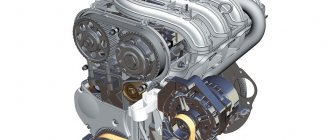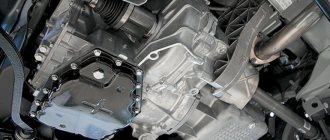The overall dimensions of the Lada Vesta have recently ceased to be a secret. The manufacturer has released data on the body dimensions of the Lada Vesta sedan. The length of the car is 4410 mm, width 1764 mm, height 1497 mm. It is worth noting that the length of Vesta in a hatchback body is also known - 4250 mm. The Vesta station wagon will have almost the same length as the sedan.
As for the ground clearance of the Lada Vesta , this figure will be 178 mm , that is, the ground clearance of the Lada Vesta will be almost 18 centimeters. Some parquet crossovers may envy this indicator.
The trunk volume of the Lada Vesta sedan, according to the manufacturer, will be equal to 480 liters . Naturally, in a hatchback body this volume will be reduced, but the station wagon will delight us with its increased capacity.
Now let's talk about the space in the Lada Vesta cabin. The wheelbase, that is, the distance from the front to the rear axle, will be 2635 mm, which is quite good. If we compare it with the same Granta or Kalina, then the base there is only 2476 mm. That is, the interior is 159 mm or 16 centimeters longer. In any case, there is more internal space, because the width is also 6.5 centimeters larger. I would also like these dimensions to have competent ergonomics, then the Lada Vesta can be recommended as a family car. In terms of dimensions, this is a full-fledged “C” class car; let’s remember Kalina and Granta are of a lower class – “B” class.
Dimensions of Lada Vesta sedan
- Length – 4410 mm
- Width – 1764 mm
- Height – 1497 mm
- Front overhang – 860 mm
- Rear overhang – 915 mm
- Base, distance between front and rear axle – 2635 mm
- Front and rear wheel track – 1510/1510 mm, respectively
- Trunk volume – 480 liters
- Curb weight – 1150-1195 kg
- Gross weight – 1625-1670 kg
- Fuel tank volume – 50 liters
- Vesta ground clearance – 178 mm
By the way, the not very large luggage volume of the Vesta sedan is apparently due to the presence of a full-size spare wheel under the trunk floor. The trunk volume of the Vesta Cross will be significantly larger.
Comparison with other models
The overall dimensions of the Lada Vesta consist of several parameters. The length of the Lada Vesta is 441 cm, which allows it to have sufficient space inside the car. The width of the Lada Vesta is also greater than that of other VAZ models. Thanks to this, passengers and the driver do not feel pinched in the shoulders. To really evaluate the advantages of the new sedan, it is enough to compare it with other domestic cars produced today by the AvtoVAZ plant:
| Options | Vesta | Kalina | Priora | Granta |
| Height, mm | 1497 | 1500 | 1420 | 1500 |
| Ground clearance, mm | 17.1 | 16.5 | 16.5 | 16 |
| Length, mm | 4410 | 4040 | 4350 | 4260 |
| Width, mm | 1764 | 1700 | 1680 | 1700 |
| Wheelbase, mm | 2634 | 2470 | 2492 | 2476 |
| Curb weight, kg | 1170 | 1090 | 1090 | 1075 |
| Maximum permissible weight, kg | 1650 | 1560 | 1580 | 1560 |
| Luggage compartment volume, l | 450 | 400 | 430 | 480 |
| Gas tank volume, l | 55 | 50 | 45 | 50 |
In almost all respects, the dimensions of the Lada Vesta exceed those of its closest “relatives”. Compared to foreign cars, the new product from VAZ also looks appropriate. Its most popular competitors cannot boast of spaciousness inside:
| Main parameters in mm | Length | Width | Wheelbase | Ground clearance |
| Hyuindai Solaris | 4370 | 1700 | 2570 | 160 |
| Renault Logan | 4345 | 1732 | 2635 | 156 |
| Kia Rio | 4370 | 1700 | 2570 | 160 |
| Lada Vesta | 4410 | 1764 | 2635 | 171 |
According to the table, it can be seen that the ground clearance of AvtoVAZ’s new product is greater than that of foreign competitors, which means that the domestic car is more adapted to different types of road surfaces, including light off-road conditions.
Ground clearance has three meanings:
- for an unloaded (empty) car;
- for a car with passengers;
- for the option with passengers and cargo in the trunk.
In the vehicle data, the clearance corresponding to the first case is most often indicated.
External speed characteristics of engines 1.6 Lada Vesta Cross and 1.8
The graph clearly shows that the developers did a very good job of tuning the 21129 engine. At 4.2 thousand rpm, the 21129 engine produces a maximum torque of 148 Nm, and at 5.8 thousand rpm - a maximum power of 106 liters .With. Yes, it does not outperform its brother - 21179, but it shows very good performance.
Interior dimensions
Dimensions of the Lada Vesta The solid size of the body of the Lada Vesta accommodates an equally spacious interior.
Five average-sized people can fit inside the car. The decent height of the Lada Vesta made it possible to increase the space between the seat cushions and the ceiling. Getting into the car is carried out at a comfortable level and there is no risk of hitting your head on the edges of the doorway. The distance from the rear wall of the front seat to the rear passenger's feet is more than 200 mm. A passenger up to 190 cm tall will not rest his knees on the back of the seat in front. The length of the front seat cushions and the rear sofa reaches 45 and 48 cm, respectively. The width of the cabin allows for comfortable seating of three passengers on the sofa in the back. These interior dimensions are close in value to the parameters of class C cars.
Vesta engine characteristics
| Production | AvtoVAZ |
| Engine make | 21129 |
| Years of manufacture | 2015-present |
| Cylinder block material | cast iron |
| Supply system | injector |
| Type | in-line |
| Number of cylinders | 4 |
| Valves per cylinder | 4 |
| Piston stroke, mm | 75.6 |
| Cylinder diameter, mm | 82 |
| Compression ratio | 10.5 |
| Engine capacity, cc | 1596 |
| Engine power, hp/rpm | 106/5800 |
| Torque, Nm/rpm | 148/4200 |
| Fuel | 92-95 |
| Environmental standards | Euro 5 |
| Engine weight, kg | 109 |
| Fuel consumption, l/100 km (for Vesta) - city - highway - mixed. | 9.0 5.3 6.6 |
| Oil consumption, g/1000 km | up to 200 |
| Engine oil | 0W-30 0W-40 5W-30 5W-40 10W-30 10W-40 15W-40 |
| How much oil is in the engine, l | 3.2 (AMT) 4.4 (manual transmission) |
| Oil change carried out, km | 15000 (better 7500) |
| Engine operating temperature, degrees. | — |
| Engine life, thousand km - according to the plant - in practice | 200 — |
| Tuning - potential - without loss of resource | 150+ — |
| The engine was installed | Lada Vesta Lada X Ray |
Benefits of the luggage compartment
The trunk of the Lada Vesta is also not inferior in terms of useful space to its “classmates”. The shapes of the body parts of the rear of the car form a wide opening in the luggage compartment. Its main parameters:
- height – 57 cm;
- length – 96 cm;
- length with the backrests of the rear sofa folded – 1.65 m;
- width – 1.4 m;
- loading height – 71.5 cm;
- volume – 450 liters, if the seats are folded – 1100 liters.
The dimensions of the sedan meet all the requirements and needs of most people, since it can easily fit the whole family or a group of friends, as well as quite large luggage. With the rear seats folded down, you can transport long and large items in the car, and the car’s solid carrying capacity will allow you to save a lot on the delivery of non-standard and heavy cargo.
Serial production of the compact Lada Vesta sedan, designed to replace the bestseller of the last decade, Lada Priora, was launched in 2015. British specialist Steve Mattin worked on the design of the new product, who managed to give the car a truly competitive appearance.
Equipment in the database
Regarding what this sedan received in 2020, this is:
- new multimedia system;
- climate control;
- as well as other “smart” options.
Otherwise, it is almost indistinguishable from previous versions. Also, as before, the following are already installed the basic version
- power mirrors;
- two pillows;
- as well as several systems responsible for the security sector.
As for the top versions, here are the Vesta builds:
- with at least a 7-inch multimedia screen;
- electrically heated windshield;
- a more advanced climate system, its management and control.
Content:
However, buyers of cars of this class pay attention not only to visual appeal, but also to practicality and functionality, which are largely determined by the dimensions of the vehicle. In this regard, Vesta is also at its best, since it surpasses in basic parameters not only domestic models, but also most competitors in its class.
Lada Vesta engines
As already mentioned, under the hood of the Russian sedan you can find both 1.6- and 1.8-liter gasoline power units, respectively, with 106 (110) and 122 (123) horses, as well as combined ones that run on both gasoline and gas 1.6 liter engines with 106 horses in teams.
At the same time, the consumption of 106-horsepower engines is 9.2/5.4/5.9, 122-horsepower units are 10.4/6.2/6.9, and combined gas-gasoline engines are 8.0/5.1/5.9, respectively, in the city, on the highway, in mixed traffic, in liters fuel for a hundred miles.
As for the configurations where 1.6-liter 16-valve power plants are installed, this ranges from the basic Standard, including Classic and Comfort configurations, to such an assembly as Luxe (with Prestige and Multimedia packages).
Power units of 1.8 liters (and, to be precise, 1.77 liter engines) go to more prestigious trim levels, starting with Comfort, including Luxe and ending with the most top-end assembly such as Exclusive.
Regarding gas-gasoline units, they are installed on such assemblies, starting with Classic, including Comfort and ending with Luxe.
↑ Body characteristics and dimensions
In the manufacture of the body of the new Lada, exclusively high-strength steel alloys are used; it was decided to do without aluminum and other expensive materials, which are popular in the modern automotive industry. This approach made it possible to offer one of the most competitive prices in class B+ in comparison with foreign models, as well as to make the body as rigid and safe as possible, with a minimum of vibrations and extraneous noise.
When producing Vesta, AvtoVAZ uses new design technologies and the selective inclusion of high-strength special alloys in the body structure. Thanks to this, it is possible to avoid deviations in the geometry and dimensions of the body, prevent door skewing, and ensure good handling.
Initially, it was planned that the new model would replace the Priora in the VAZ line, although in all respects the new model is superior to the Tolyatti bestseller.
Main dimensions of Lada Vesta, meters:
- height – 1.497;
- body length – 4.41;
- wheelbase - 2.635;
- body width – 1.764;
- front track width – 1.5;
- rear track width - 1.51;
- turning radius – 5.2;
- aerodynamic drag coefficient – 0.82;
- ground clearance - 0.171.
AvtoVAZ specialists, when designing the overall dimensions of the Lada Vesta, were guided by its subsequent operation in domestic conditions, so the car is ideal for traveling on Russian roads. For example, thanks to the increased wheelbase, the car has excellent directional stability and controllability even on uneven road surfaces. A sufficiently high ground clearance makes it possible to overcome difficult sections of the road that many competitors cannot overcome.
“Made with us” and on Yandex.Zen
| Power unit | Sedan | Hatchback |
| 1.6 l., 8 cl. (11189), 64 kW (87 hp), Euro 5, manual transmission (JHQ) | ||
| 1.6l., 16kl. (21129), 78 kW (106 hp), Euro 5, manual transmission (JHQ) | ||
| 1.6l., 16kl. (21129), 78 kW (106 hp), Euro 5, AMT (2182) with kick-down mode | ||
| 1.6l., 16kl. (HR16DE) Renault-Nissan engine, 84 kW (114 hp), Euro 5, manual transmission (JHQ) | ||
| Body/dimensions | Sedan | Hatchback |
| Weight, kg: | ||
| equipped | 1150-1195 | |
| with full load | 1625-1670 | |
| Dimensions, dimensions, mm: | Biggest in class | |
| Length | 4410 | 4250 |
| Width | 1764 | |
| Height | 1497 | |
| Wheelbase, mm | 2635 | |
| Front/rear axle track, mm | 1500/1510 | |
| Turning radius, m | 5,2 | |
| Aerodynamic factor, m2 | 0,82 | 0,85 |
| Maximum speed, km/h | 185 | |
| Acceleration time to 100 km/h, s | 10,3 |
Dimensions of Lada Vesta in comparison with competitors
| Automobile | Length, mm | Width, mm | Height, mm | Wheelbase, mm | Front/rear axle track, mm |
| Lada Vesta | 4410 | 1764 | 1497 | 2635 | 1500/1510 |
| Hyundai Solaris | 4370 (+40) | 1700 (+64) | 1470 (+27) | 2570 (+65) | 1495/1502 (+5/+8) |
| Volkswagen Polo sedan | 4384 (+26) | 1699 (+26) | 1465 (+65) | 2552 (+32) | 1460/1498 (+40/+12) |
| Kia Rio | 4370 (+40) | 1700 (+64) | 1470 (+27) | 2570 (+65) | 1495/1502 (+5/+8) |
| Lada Granta sedan | 4260 (+60) | 1700 (+64) | 1500 (-3) | 2476 (+159) | 1430/1414 (+70/+96) |
In comparison with its closest competitors, foreign cars of class B, Vesta is significantly larger than them. For a lower price, you get not only a more fully equipped car, but also a larger one. I was surprised by the size of the Grant; surprisingly, it turned out to be the same in width as the more expensive models.
Characteristics of the HR16DE engine
| Engine capacity | 1597 cm3 |
| Power | 109 hp |
| At rpm | 6000 |
| Torque | 150/4400 n*m |
| Supply system | Distributed injection |
| Presence of turbocharging | — |
| Gas distribution mechanism | DOHC |
| Cylinder arrangement | Row |
| Number of cylinders | 4 |
| Cylinder diameter | 76 mm |
| Piston stroke | 88 mm |
| Compression ratio | 9.8 |
| Number of valves per cylinder | 4 |
| Fuel | AI-95 |
Engine
The developers have prepared three engine options running on high-quality gasoline, adapted to Euro-5 standards. The volume of each engine is 1.6 liters. AVTOVAZ units are presented in two versions: an 8-valve engine from the VAZ-11189 and a 16-valve engine from the VAZ-21129. The imported version is the brainchild of the Renault-Nissan alliance (HR 16DE) with a 114-horsepower engine. Since 2005, this power unit has been used on many alliance models, including the NISSAN SENTRA localized at IZHAVTO.
- LADA VESTA engine
But that is not all. VESTA will also be equipped with a new 1.8 liter engine. developed by AVTOVAZ. Its basis is a 123-horsepower engine installed on PRIORAS by a company from Tolyatti, SUPER-AUTO. In the future, the developers are going to increase its power to 125-130 hp.
Based on what Bo Andersson said, we can conclude that in 2016 the LADA VESTA SPORT will appear, which will take part in Russian automobile competitions. And the engine will have a power of about 150 hp. VAZ workers say that it is not advisable to install a more powerful one.
Most likely, other versions of the power unit configuration are possible in the near future. For example, the gas tank already has a dedicated space for a gas valve if the car is converted to gas fuel. The idea is promising, given the rise in fuel prices and the increase in the number of gas stations. A car running on liquid fuel or gas is at the peak of popularity among car owners today.
Transmission
Mechanical
Previously, it was planned to install a manual transmission 2180 developed by AVTOVAZ. But it had one drawback - noise during operation. The engineers were unable to completely eliminate the problem within the time allotted to them, so it was decided to use the foreign manual transmission Renault JHQ. In addition to quieter operation, the box also has the advantage of clear switching. There are also disadvantages, its price is 3 thousand rubles more.
Robotic
When choosing a car with a 1.8 liter engine. you will have the opportunity to install not only a manual transmission, but also a “robot” developed jointly with the German ZF.
5-speed robotic transmission AMT
This is what the AMT handle looks like in the interior of the LADA GRANT
Flaws:
When parking on a hill, the car rolls back. You must either adjust the gas or put on the handbrake.
Advantages:
the possibility of breakdown due to an incorrectly engaged gear is excluded, for example, if you engage the reverse gear while moving forward;
It is possible to use both manual and automatic switching modes (two in one);
Possibility of rapid acceleration as on mechanics, start moving with slipping; KICK-DOWN mode - shift to a lower gear for better acceleration;
There is no need to apply the brake when changing gear from reverse to forward at speeds up to 5 km/h. This is convenient if you are trying to get out while you are stuck;
Fuel consumption is 6.5 liters per 100 km in the city and 5.1 liters per 100 km on the highway;
The ability to start driving immediately after starting the engine, including if it’s 45 outside;
Automatic adjustment to the driving style of each driver - aggressive and calm styles;
Compared to the automatic transmission, the design turned out to be cheaper, simpler and more reliable. According to experts, the VAZ gearbox is the best of all the “robots” they have ever driven. At the factory they even want to conduct an experiment and find out if there is anything better.
Body
The body is made of steel, and such modern materials as composite or aluminum are absent in it due to economy. This means that the weight of the car, relative to, for example, the PRIORA, has not changed. But VAZ employees say that there was no goal to reduce the weight of the car.
First of all, engineers focused on ensuring a high level of passive safety, reducing noise, vibration and increasing rigidity. And now they claim that they have coped with the task. According to them, the body of the LADA VESTA in torsion is several times stiffer than Priorov’s. This was achieved through the use of computer modeling, which made it possible to correctly distribute forces and high-strength alloys. Such achievements give hope that doors will stop sticking and squinting, plastic will not creak in the cabin, and handling will become sharper.
Suspension
This prototype uses the suspension found on standard VAZ models. The suspension of modern AVTOVAZ models can be described as follows: a McPherson strut in front, a transverse beam with increased elastic properties in the rear. In fact, the similarity ends with such elements.
What's new? Innovations affected the front module. Its design is based on a subframe, which allows for greater rigidity and fewer technological operations during assembly. This approach allows us to reach a new level of vibration and acoustics and achieve better vehicle handling characteristics. In general, the suspension geometry in this version is more advanced.
The lower placement of the steering rack is another successful achievement. In the presented pilot project, the steering rack rods act to turn the wheels directly behind the hubs. In modern models of the auto giant, the steering rack rods work differently: the wheels are turned by levers at the base of the shock absorber struts. The benefits of the proposed solution are as follows: car control reaches a new, better level.
What do you have to express regret about? The automaker has taken the path of unification with production models: the electric power steering is located on the steering column, rather than built into the steering mechanism.
The anti-roll bar has also undergone changes. The torsion bar began to look completely different; in addition, long struts were added. As a result, sensitivity has increased by an order of magnitude, and controllability has improved.
To reduce overall costs and in the interests of unifying the car's components, the manufacturer used the Renault-Nissan rear suspension. At the exit we have a transverse beam, which has spaced springs, and is complemented by effective drum brakes. Drums again, you say, but the engineers have a different view: cheap and cheerful. In civilian driving conditions, such brakes are not inferior in efficiency to disc brakes and are better protected from dirt and dust, which means they will last longer.
As for the independent suspension, this option turned out to be too expensive for a budget car, so it had to be abandoned.
The ground clearance of the experimental Vesta model when fully loaded is not particularly different from other Lada models and is 171 mm.
It remains to be added: the suspensions are distinguished by their long-travel characteristics, which is unusual for passenger cars.
Lada Vesta station wagon and hatchback
These body types will have their own chassis settings. At a minimum, they will have different springs installed, and at maximum, the ride and handling settings will be changed. But there will be no all-wheel drive. In this case, the rear suspension will be very expensive.
LADA VESTA was created on the new universal platform LADA B, developed independently by AVTOVAZ. 1,184 of the 1,480 nodes are completely unique.
Information from the website of the club of future car owners
↑ Comparison of dimensions with other cars in this class
When developing the Lada Vesta, the designers of the Togliatti automaker took into account the dimensions of the main competing models of other brands, and managed to surpass them in all key parameters.
| Model name | Body length, m | Wheelbase size, m | Body width, m | Ground clearance, m |
| Lada Vesta | 4,41 | 2,635 | 1,764 | 0,171 |
| Volkswagen Polo | 4,384 | 2,552 | 1,699 | 0,17 |
| Hyundai Solaris/Kia Rio | 4,37 | 2,57 | 1,7 | 0,16 |
| Renault Logan | 4,346 | 2,634 | 1,735 | 0,155 |
| Ford Fiesta | 4,32 | 2,489 | 1,722 | 0,167 |
In comparison with other B-class sedans presented on the domestic market and located in approximately the same price category as the VAZ model, Vesta is longer, taller, wider and has greater ground clearance. The increased dimensions of the body have a positive effect on its performance characteristics and convenience in everyday trips.
Vesta 21129 engine tuning
Aspirated
As mentioned above, Vesta motor uses the new M86 controller and today there are some problems with its firmware. You can do a regular chip tuning, buy a 4-2-1 exhaust manifold, a 51 mm exhaust system. This will increase the power slightly (5-8 hp) and improve the sound. In a good way, there is no need to climb further, the car is quite heavy and you won’t get any crazy dynamics anyway; a lightweight Priora or 2114 with a similar tuning will be ahead.
ENGINE RATING: 3+
<<BACK
↑ Interior and luggage compartment dimensions
The new platform used to create the sedan made it possible to make the car not only larger, but also more comfortable. The Lada Vesta's interior dimensions are also very impressive: there is much more free space for both the driver and passengers than in previous Lada models.
Main interior dimensions, meters:
- the distance between the driver's seat cushion and the ceiling is 0.93-0.99;
- distance between the rear passenger seat cushion and the ceiling – 0.885;
- free space between the back of the front seat and the legs of the passenger sitting behind – 0.226;
- front seat cushion length – 0.45;
- rear seat cushion length – 0.48.
Taking into account the specifics of operating budget sedans in our country, which involves the periodic transportation of certain cargoes, the designers made sure that Vesta received a fairly spacious trunk.
Main dimensions of the cargo compartment, meters:
- height – 0.573;
- length - 0.962 (1.675, if the rear seat backs are folded);
- width max./min. – 1.424/1.033;
- loading height – 0.717.
The useful volume of the trunk is about 480 liters, and it can accommodate cargo weighing up to 400 kilograms.
Thus, AvtoVAZ specialists managed to design not only an attractive and reliable car, but also a very practical, convenient and functional one, maximally oriented towards the average Russian driver with an average income.
As a summary: about the prospects of the Lada Vesta with a CVT
As for the fashionable trend of CVT transmissions, the national characteristics of our user auto audience are to constantly confirm historically established opinions that they say, what kind of Russian does not like aggressive driving.
Therefore, the variator is too intelligent a unit for our brother, and it is too expensive to change it over and over again due to breakdowns due to aggressive road behavior.
Based on this, it is unlikely that the manufacturer will install a CVT on the Lada Vesta 2022 en masse, despite the fact that since November 2019 this sedan began to be equipped with a Jatco CVT paired with a Nissan engine of 113 horses.
Tags: characteristics











